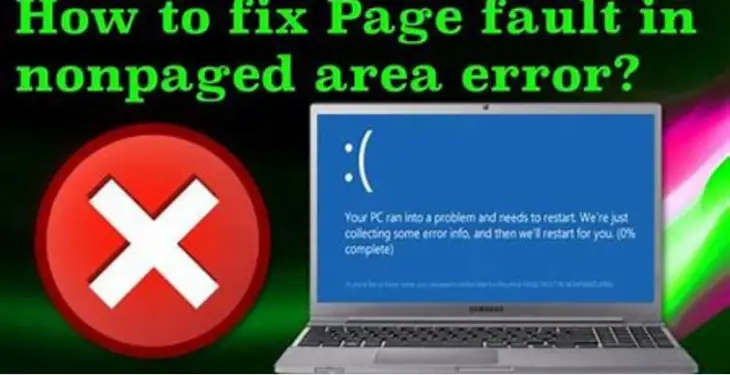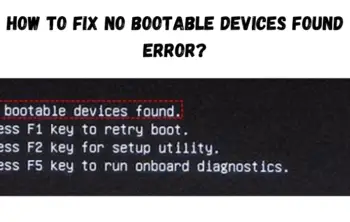Page Fault in Non-paged Area is as close as Windows comes to saying, “invalid memory reference.” To really understand what’s going on, one needs to understand paged memory, which divides addressable memory space up into a collection of 4K-sized memory pages.
The OS can address a very large number of pages, where only some of those pages will actually be resident in RAM. In most cases, when a program or the OS references a specific memory page, if it’s not resident in RAM, the page manager throws a “page fault” (page not present) status.
Ultimately, this means the requested page gets read from the page file. To make room for something new if room is needed, an old memory page (one that hasn’t been accessed recently) will be swapped out to make room for the new page as it gets swapped in.
Certain pages that the OS uses frequently are “locked in” to RAM. That is, they do not participate in memory paging and should always be present and available when requested. Windows refers to this memory allocation as the “non-paged pool” and it appears as such in Task Manager, as shown below.
The Page Fault in Non-paged Area BSOD signals a condition where the OS has requested a locked-in page and gets a page fault instead. The reason why Microsoft handles this as a stop code and generates a BSOD is because this error is not supposed to occur, and it directly affects the operating system (only highly privileged, important memory pages get allocated into the non-paged pool).
What Causes Page Fault in Non-paged Area?
As described in the Microsoft Docs page for Page Fault in Non-paged Area, this particular stop code may follow after installation of what it calls “a faulty system service or faulty driver code.” By and large, system services come from Microsoft as part of OS releases, upgrades or updates.
If they’re at fault, you’ll figure this out quickly because Microsoft will include this possibility in its “Known Issues” lists for such things. Likewise, there will be plenty of online traffic to report, document, and exclaim about such problems.
While bad Windows updates do happen from time to time, the Page Fault in Non-paged Area code is far more likely to come from a faulty driver. To see if the problem is caused by a driver, note the file listed on the BSOD (ex: nvlddmkm.sys) and consider whether you’ve recently updated a driver or installed a new device.
How would you Fix Page Fault in Non-paged Area BSODs?
When it comes to faulty system services, Page Fault in Non-paged Area, the best approach is to uninstall (or roll back from) the upgrade or update that caused the problem. If it came from a clean Windows install, it’s time to do another one, using a different (and known to be good and working) OS version instead.
If the problem comes from a driver, first check the device manufacturer’s website for a newer version of the driver. If so, download and install it. If not, try rolling back to a prior version. To roll back a driver:
- Launch Device Manager. You can get there from the Windows + X menu.
- Right click on the device in question and select properties.
- Click the Roll Back Driver button.
However, many devices won’t have the Roll Back Driver button enabled and, even then, it will only take you back one version. Otherwise, you’ll need to hunt for an older driver through the manufacturer’s site (or some reputable third-party source, such as the excellent French Station Drivers website).
Look for Disk Problems for Page Fault in Non-paged Area.
Disk errors or specific problems with system files can also cause the Page Fault in Non-paged Area BSOD. In order to rule out or fix these issues:
- Open a command prompt as administrator. You can get there by searching for cmd, right-clicking and selecting Run as administrator.
- Enter DISM /Online /Cleanup-image /Restorehealth to find and replace any damaged OS components.
- Enter SFC /scannow to check for damaged system files.
These aren’t the most likely cause of a Page Fault in Non-Paged Area BSOD, but they are quick and easy steps you can take that may solve the problem.
Memory Could Be a Cause of Page Fault in Non-paged Area BSODs
Other potential causes for the Page Fault in Non-paged Area BSOD include memory problems. This might mean issues with RAM, L1 or L2 cache on the CPU chip itself, or even video RAM on a graphics card. Finding such issues requires a process of elimination.
It’s easiest to check RAM, and more difficult to check CPU cache and video RAM. The free, open-source Memtest86+ utility is a good tool for checking PC RAM. I keep a bootable version of MemTest86+ on my Ventoy repair flash drive (it’s named mt531b.iso, to reflect the most current MemTest86+ version).
Using the tool generally requires an overnight run, so I boot to the MemTest image just before I go to bed, and let it run all night so I can see what it’s doing (and finding). Malaysian logger Raymond.cc offers an interesting list of 6 free programs to check your video card memory for errors.
I’m not aware of any tools that check CPU cache per se, though I did find an interesting StackOverflow item that uses DotNet libraries to come close. If memory problems are indeed present and none of the other techniques I’ve described lead to solutions, keep your eyes peeled for related stop codes. These can help point you more directly at potential causes and fixes:
- SYSTEM_SERVICE_EXCEPTION
- KMODE_EXCEPTION_NOT_HANDLED
- MEMORY_MANAGEMENT
- IRQL_NOT_LESS_OR_EQUAL
If you see the Page Fault in Non-paged Area error, try rolling back any recent Windows or driver updates. If you’ve just installed new software, uninstalling it could fix the error as well. You can further diagnose and solve the problem by running some tests or temporarily disabling your antivirus.
Some Blue Screens of Death (BSODs) are difficult or impossible to diagnose and fix, whereas others are pretty straightforward. Luckily, a BSOD with a “page_fault_in_nonpaged_area” message is often fixable. Here are some things you can try.
What Actually Causes Page Fault in Non-paged Area?
So, what is the Page Fault in Non-paged Area? When your computer is performing tasks, it is constantly loading programs and files in and out of your computer’s Random Access Memory, more commonly called RAM. If your Windows PC runs out of RAM, or a program or file is inactive for a long time, Windows will start moving things from RAM to your hard drive or SSD instead.
Those ‘things’ are stored in the Page File. If something interferes with reading or writing to the page file (pagefile.sys) —or directly with your RAM itself—there is a good chance, you’ll get a Blue Screen of Death (BSOD). There are a handful of things that can cause the Page Fault in Non-paged Area issue in particular:
- A faulty driver or system service
- A corrupted hard drive or solid-state drive (SSD)
- Malfunctioning Antivirus Software
- Faulty Memory (RAM, Cache, or VRAM)
Diagnosing the Problem of Page Fault in Non-paged Area
Generally speaking, Page Fault in Non-paged Area, your first troubleshooting steps should always focus on anything that recently changed on your PC. Did you just update a driver, a program, or Windows? Did you install new hardware? If you did — start, there.
Roll back the driver you updated, remove the program, or try uninstalling the latest Windows update. If you installed new hardware, remove it and see if the issue persists. If you aren’t sure what recently changed, you need to do a bit more digging.
When you get this BSOD, it often displays what was running at the time that things went wrong on the “What Failed” line. If your BSOD displays something there, start by Googling it. It’ll probably be enough to point you in the right direction. For example, if the thing that failed returns results for NVIDIA, you should definitely start by reinstalling or rolling back your graphics drivers.
General Troubleshooting in Page Fault in Non-paged Area
If the BSOD doesn’t give you any clue what the problem might be, and you aren’t sure what was updated recently, the problem becomes more challenging to solve. Here are a few things you can try. Some of them might help you figure out what the problem is, while others might fix it.
Remove New Hardware from Page Fault in Non-paged Area.
If you recently installed new hardware and your computer suddenly started experiencing BSODs, you should definitely try removing the new hardware first. While you’re at it, make sure your other components are seated properly. It is possible that something got bumped during the installation.
Check the Event Viewer in Page Fault in Non-paged Area.
- The Event Viewer is exactly what it sounds like — it lets you view important events that affect your PC. Events are sorted into a few different categories, like “Windows logs” and “Applications and Service Logs,” for example. They’re also sorted by severity: Information, Warning, and Error.
- There is a lot of information packed into Event Viewer, so it is probably worth reading a bit about what it is and how it works before you dive straight in.
- In all likelihood, some error that causes a BSOD will be found under Windows Logs > System.
- Check through the “Details” tab. Try to narrow your results to things that happened at the same time as the BSOD.
Check Recently Updated Programs in Page Fault in Non-paged Area.
- If you have installed dedicated drivers for your CPU, GPU, sound card, network adapter, motherboard, or any other component of your computer, they’ll be listed in the “Apps & Features” section of the Settings app. You can use that to determine what has recently been updated, and it might shed some light on what caused the problem.
- Click the Start button, type “apps and features” into the search bar, and then hit Enter or click “Open.” (You can also head to Settings > Apps > Apps & Features to find this window.)
- The search result will be “Apps & Features,” not “Apps and Features,” but who wants to type an ampersand (the “and” sign) unless they need to?
- Click the Start button, type.
- By default, the list of programs is sorted alphabetically, but we need to change it so that they’re sorted by install date. Click the label “Name” next to “Sort By” and change it to “Install Date.”
- If you spot any drivers that have been updated since you noticed the BSODs started, try installing an older version, or reinstalling the current one.
Disable Your Antivirus in Page Fault in Non-paged Area.
Even the best antivirus software sometimes makes mistakes. It isn’t likely, but your antivirus may be somehow interfering with reading from or writing to the paging file somehow, thereby causing the BSOD. The simplest way to check if your antivirus is the problem is to disable it temporarily.
If the crashes stop, you’ve found the culprit. Fixing the issue is a bit harder. If your antivirus is at fault, it is probably a result of access protection or real-time threat detection. You’ll need to add exceptions to both for the Windows paging file. How exactly you do that depends on what antivirus software you’re using.
You’ll need to consult the documentation for your specific software to find out the details. Alternatively, you could remove your third-party antivirus completely and let Microsoft Defender take over. Microsoft Defender struggled for a while, but it has been as good as any third-party option for a few years now. It is extremely unlikely that Microsoft Defender would cause problems like this.
Run a Memory (RAM) Test for Page Fault in Non-paged Area.
Modern computer components are phenomenally complex, and like all things, they do sometimes break. Your RAM is no exception. Luckily, there are some tests you can run to determine if your RAM is faulty. If your RAM is faulty, it is almost definitely the cause of the BSOD.
There isn’t much you can do to fix faulty RAM. You can try cleaning the contacts and resetting it, but it probably won’t help. You’ll have to replace it. The good news is that RAM isn’t particularly expensive, and it is widely available. Rummaging around inside of your computer can cause permanent damage if you aren’t careful and don’t know what you’re doing.
If you decide to change out your RAM yourself and you’ve never done it before, make sure you take the proper precautions. Remember to be gentle. Computers aren’t made of glass (anymore), but they’re not usually designed to take a beating either. Swapping out RAM on a desktop PC is pretty easy and doesn’t take more than a few minutes.
Laptops are a different story — they’re much more difficult to open up and work on, and in some cases the RAM is permanently attached to the motherboard. If your laptop does have RAM that is permanently attached, you’ll need to get it serviced by the manufacturer or a professional.
Run Chkdsk in Page Fault in Non-paged Area.
Your RAM isn’t the only physical component that could be at fault — it could also be your hard drive or SSD. Sometimes corruption occurs because of a software fault, other times it occurs because of a hardware problem. Windows comes packaged with a tool designed specifically to diagnose and repair issues with hard drives or SSDs: the Check Disk Utility.
Check Disk, usually referred to as Chkdsk, can repair some basic problems, and help mitigate more severe ones. If there is a problem with the file system, or there is a corrupted sector due to a software fault, it can probably fix it completely. If your hard drive has a corrupted sector due to physical damage, the most it can do is prevent it from being used in the future.
Corrupted sectors or problems with the file system can cause BSODs; running Chkdsk may fix the problem completely. Like with most computer parts, there is basically nothing you can do to repair a failing hard drive or SSD, you just have to replace it. If you find that your drive is failing, be sure to back up any important information that you might have saved on it. A hard drive can completely fail at any time and leave you unable to recover important files.






